Effects used:
Premiere: Noise, VR Chroma Light Leaks, VR Color Gradients
After Effects: Grid
DTC 208 Introduction to Digital Cinema
Washington State University Vancouver
Effects used:
Premiere: Noise, VR Chroma Light Leaks, VR Color Gradients
After Effects: Grid
I couldn’t get the mask to follow the movement of the camera, so it doesn’t quite have the effect we were going for.
Audio:
Only Acting – Kero Kero Bonito
A lot of my footage ended up being shaky, and when I mentioned to my Aunt that I wanted to reshoot, she told me she had already decorated for Christmas.
Audio:
Lontano – Ennio Morricone
Audio:
Biscuit – Portishead
Sour Times – Portishead
Polish Girl – Neon Indian
Nowhere Near – Yo la Tengo
In The Carnival of the Ages, a beautiful, dreamlike world unfolds, blending 1950s styling, carnival aesthetics, and space-age futurism to create a mesmerizing vision of retrofuturism. The visual style is a nearly realistic amalgam of these elements, but it retains an otherworldly, alien-like quality that adds to the film’s allure. The detailed world-building is enhanced by the audio, which perfectly complements the surreal yet nostalgic visuals. Every frame is meticulously crafted, creating an immersive experience that feels both familiar and strange.
What impresses me most is the attention to detail. Each scene offers rich visual layers that feel almost tangible, as though this retro futuristic world could truly exist. The short film’s aesthetics are so captivating that I would love to see them expanded into a feature-length film.
I believe Artificial Intelligence can play a significant role in creating worlds like this. AI has the potential to unlock new levels of creativity and detail in cinema, allowing filmmakers to bring fantastical visions to life in ways previously unimaginable. I see no problem with its usage, as it could help create breathtaking, imaginative worlds that push the boundaries of what we currently know in filmmaking. I am also a huge fan of retro-futurism so this was bound to be compelling for me from the start.
The railroad scene from the film Duel uses a lot of unique camera techniques and continuity editing that assist the viewer’s temporal and spatial awareness, and helps to build tension. The 180-degree rule is used throughout the scene as we watch how the car and truck are consistently oriented on the screen. The truck is always pushing the car towards the left, which helps the audience understand the direction of movement and the spatial relationship between the vehicles. Match-on-action editing ensures fluidity as the truck gradually pushes Mann’s car toward the passing train, making every movement seamless and heightening the sense of real-time danger. Eyeline matches are also used effectively, cutting between Mann’s terrified gaze and the truck behind him, allowing viewers to share his growing panic. As the train moves down the tracks, Spielberg alternates between shots of the train and the car being pushed. This cross-cutting heightens the suspense as the audience anticipates a potential collision. The careful continuity editing ensures that the spatial and temporal relationships are clear, making the tension even more palpable. Time is manipulated through this editing, prolonging the moment of danger through quick cuts between the various subjects
and keeping the audience on edge until David eventually escapes.
The scene in Shameless is chaotic, but it is organized in a way that makes it easy for viewers to follow. This “controlled chaos” keeps the audience engaged without feeling overwhelmed by the flurry of action. There is a lot of movement and action, yet continuity is maintained throughout, allowing the scene to flow smoothly. The strategic use of the background, midground, and foreground shows the disorder of the family in nearly every frame, especially in the opening moments when Fiona looks in the mirror and closes the door to reveal her brothers. The continuity editing emphasizes Fiona as the central figure, insinuating she is the backbone of the family. The scene’s editing style ensures that the focus stays primarily on her actions. A key element of the scene is the milk, which acts as an anchor object. Its journey from the fridge to the sink and table creates a sense of coherence and serves as a visual cue for the quick passage of time. The milk’s movement helps viewers navigate the scene’s fast pace, providing clarity amid the chaos. All of the editing and framing choices in this scene demonstrate the familial dynamics and make the scene’s complexity digestible.
The 1960 film The Cranes Are Flying is filled with striking and compelling scenes. The director, Mikhail Kalatozov, is notably intentional with his use of the camera and framing, both of which enhance the storytelling and accentuate the performances. This Soviet film is set during WWII and tells the story of Veronika and Boris, who are recently engaged. Boris volunteers to join the Soviet fight against the Germans, deeply affecting Veronika. The Cranes Are Flying portrays the profound grief experienced when a loved one is sent to war.
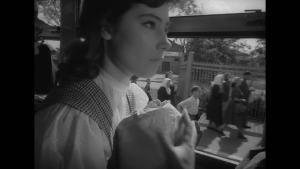
Medium close up (MCU)

Medium close up (MCU)
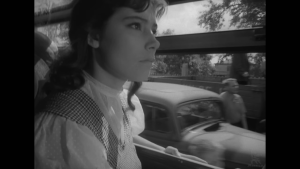
Medium close up (MCU)

Medium close up (MCU)
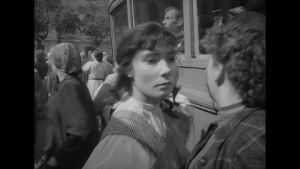
Medium close up (MCU)
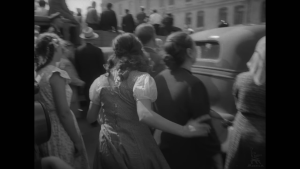
Medium long shot (MLS)
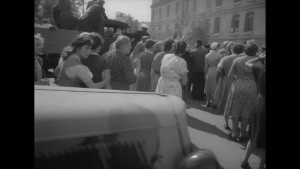
Long shot (LS)
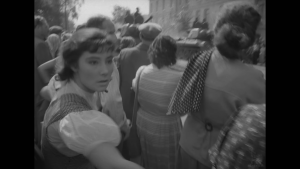
Medium close up (MCU)

Medium close up (MCU)

Medium close up (MCU)
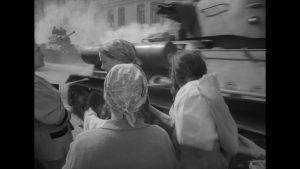
Medium (M)
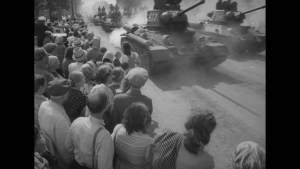
Extreme long shot (ELS)
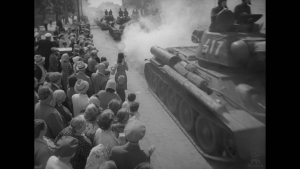
Extreme long shot (ELS)

Extreme long shot (ELS)
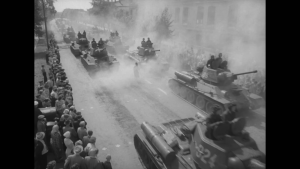
Extreme long shot (ELS)
Veronika is late for Boris’ farewell, her last chance to see him before he goes to war. The framing in this scene captures the frantic and urgent emotions that Veronika feels and reflects in her movements. Starting with the medium close-ups on the bus, Veronika is peeking her head in and out of the window, suggesting that something lies ahead. This framing allows the audience to focus on her while still grasping her surroundings. The camera follows her as she runs off the bus and continues with a medium close-up as she searches for the quickest way out of the crowd. The medium close-up allows the audience to see her thought process as she navigates the disorderly environment.
She then runs into the crowd, with variations in how she, the subject, is framed. Both the long shot and medium long shot capture her disoriented thoughts, manifested in her movement as she weaves through the crowd. At several moments as she runs, she is obstructed from view by surrounding objects and people, which helps to set the scene and convey her anxious state. The film then returns to several more medium close-ups, where her distraught state of mind is evident, while tanks roll along in the background. She runs away from the camera to enter the road where the tanks are rolling. The cameraman steps onto a lift, creating a high angle. The high angle, combined with the extreme long shot, makes Veronika appear small and insignificant, yet her actions remain distinct. The extreme long shots of her running through the path of the tanks also convey that her objections to Boris going to war are part of an issue much larger than herself.
The broad set of framing choices in this scene communicate several things. The medium close-ups and medium shot not only emphasize how crucial it is for her to reach Boris’ farewell dinner on time but also reveal how the situation has put her in a state of distress. While still conveying a sense of urgency, the long shots and extreme long shots also shows the chaotic situation that has caused her distress, thereby contextualizing her actions. This scene is executed without cuts, relying entirely on the cameraman’s work. The framing and camera movement masterfully elevate Veronika’s emotions and actions.